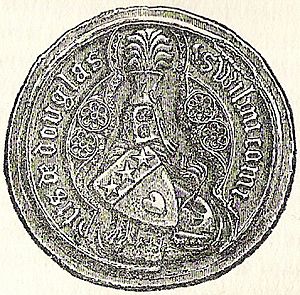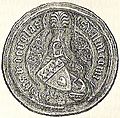William Douglas, 1st Earl of Douglas facts for kids
Quick facts for kids
William Douglas
|
|
|---|---|

Seal of William Douglas, 1st Earl of Douglas.
|
|
| Born | c. 1323 Douglas, Lanarkshire, Scotland |
| Died | 1 May 1384 (aged 60–61) Douglas, Lanarkshire, Scotland |
| Title | Earl of Douglas |
| Tenure | 26 January 1358 – 1 May 1384 |
| Other titles | Earl of Mar Lord of Liddesdale |
| Nationality | Scottish |
| Residence | Hermitage Castle Tantallon Castle |
| Spouse(s) | Margaret, Countess of Mar |
| Issue | James Douglas, 2nd Earl of Douglas Isabel Douglas, Countess of Mar George Douglas, 1st Earl of Angus (illegitimate) Lady Margaret Douglas (illegitimate) |
| Parents | Sir Archibald Douglas Beatrice de Lindsay |
|
|
|
William Douglas, 1st Earl of Douglas (born around 1323 – died May 1, 1384) was a very important Scottish leader. He was the head of the powerful Black Douglas family. Under his leadership, the Black Douglases became even more important in Scottish politics. They also became very strong military leaders in southern Scotland.
Contents
Growing Up in Scotland
William Douglas was the son of Sir Archibald Douglas and Beatrice de Lindsay. His uncle was "Sir James the Good", who was a trusted helper of King Robert I of Scotland.
When William's father died in 1333, William was still young. He was placed under the care of his relative, William Douglas, Knight of Liddesdale. William went to school in France.
In 1342, his uncle Hugh the Dull gave William the Lordship of Douglas. However, Liddesdale managed William's lands in a greedy way. He even took control of some of the Douglas family's territories for himself.
Returning Home and Fighting Back
William Douglas came back to Scotland in 1348. He immediately started to get his lands back in order. From 1346 to 1347, King David II and other nobles were held captive by the English. Edward Baliol used this chance to attack and damage much of southern Scotland.
After William returned, he gathered his men. They drove the English out of his family lands in Douglasdale. William fought like his uncle, Sir James the Good. For several years, he led a sneaky war against the English in the Ettrick Forest and Jedforest areas.
William Douglas later became one of the people chosen to talk with the English. Their goal was to get King David II released from captivity.
A Major Conflict
In 1353, Edward Baliol was staying at Buittle in his family lands in Galloway. William Douglas led a raid there to make him leave. This was because Baliol had lost the right to those lands.
After this raid, William was returning through the forest. He found Liddesdale hunting on what William saw as his own land. This was the final straw after years of bad feelings. Liddesdale had taken over Douglas family lands. Also, Liddesdale had fallen out of favor with the King. This was because he had done some bad things, like hurting Sir Alexander Ramsay. Another reason for the conflict was Liddesdale's secret deal with the English to gain his own freedom.
William Douglas attacked Liddesdale and killed him. In February 1354, King David gave William a new charter. This document gave him all the lands that his uncle Sir James, his father Sir Archibald, and Liddesdale himself had held.
Battles and Diplomacy
In 1355, the peace agreement with England ended. Douglas and the Earl of Dunbar and March decided to attack Norham Castle. One of Douglas's captains, Sir William Ramsay, was told to attack the lands around Norham. He was to burn the town to make the English soldiers come out and fight.
Ramsay did this, and the English chased them. Douglas and March were waiting in a forest nearby. The English were ambushed by the Scottish forces and completely defeated. After this Battle of Nesbit Moor, Douglas and March joined with the Earl of Angus and their French allies. Together, they took the town of Berwick.
They could not take Berwick Castle and had to leave before the English army arrived. King Edward III then attacked the Lothians in an event called the "Burnt Candlemas". His supplies were running low, and Scottish tactics prevented him from finding more food. Edward had to go home. On his way, Douglas's men ambushed him near Melrose.
After Edward's retreat, Douglas arranged a peace agreement with the English. He also got permission to visit the captive King David. Douglas then went to France and fought with Jean le Bon against Edward of Woodstock, the Black Prince. Douglas was present at the Battle of Poitiers. There, the French King made him a knight. Douglas fought bravely, but when the battle seemed lost, his men pulled him away. He did not want to be captured by the English.
Douglas returned to Scotland by the autumn. He was involved in peace talks with the English. As part of this, Douglas became a "March Warden," a guardian of the border. In this role, Douglas took Hermitage Castle from the English. Douglas was also part of the parliament that met in 1357. This meeting finalized the release of King David through the Treaty of Berwick. Douglas himself helped guarantee the King's release.
Becoming an Earl
William Douglas was given the title of Earl of Douglas on January 26, 1358. To show his new important status, he built Tantallon Castle. This was a strong Medieval castle with a large wall around it.
In 1364, Douglas joined King David II in trying to make a deal with England. This deal would have erased Scotland's debt to England. In return, King Edward III's son would have become the Scottish King. However, Scotland's independence would still be guaranteed. This plan never worked out.
When Robert the Steward became King Robert II, Douglas made peace with him. He was then given an important legal job in southern Scotland in 1372. The last years of Douglas's life were spent fighting in border raids. He died in Douglas, South Lanarkshire on May 1, 1384.
Family Life
William Douglas married Margaret of Mar in 1357. She was the Countess of Mar in her own right. They had two children:
- James Douglas, 2nd Earl of Douglas (1358–1388)
- Lady Isabel Douglas, Countess of Mar (1360–1408)
The Earl of Douglas also had two children with Margaret Stewart. She was the Countess of Angus. Their children were:
- George Douglas, who later became the Earl of Angus.
- Lady Margaret Douglas, who received lands in 1404 from her half-sister, Lady Isabel Douglas.
He is also thought to have had another daughter, Joan Douglas. She married William Dacre, 5th Baron Dacre.
Images for kids


